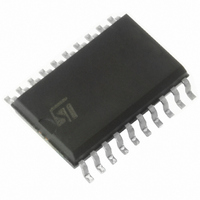E-L6911C STMicroelectronics, E-L6911C Datasheet - Page 9

E-L6911C
Manufacturer Part Number
E-L6911C
Description
IC CTRLR 5BIT PROGR STPDN 20SOIC
Manufacturer
STMicroelectronics
Type
Step-Down (Buck)r
Datasheet
1.E-L6911C.pdf
(20 pages)
Specifications of E-L6911C
Internal Switch(s)
No
Synchronous Rectifier
Yes
Number Of Outputs
1
Voltage - Output
1.3 ~ 3.5 V
Current - Output
1.3A
Frequency - Switching
200kHz
Voltage - Input
5 ~ 12 V
Operating Temperature
-40°C ~ 150°C
Mounting Type
Surface Mount
Package / Case
20-SOIC (7.5mm Width)
Lead Free Status / RoHS Status
Lead free / RoHS Compliant
Power - Output
-
Lead Free Status / Rohs Status
Lead free / RoHS Compliant
Available stocks
Company
Part Number
Manufacturer
Quantity
Price
overcurrent protection this relationship must be satisfied:
Where I is the inductance ripple current and I
In case of output short circuit the soft start capacitor is discharged with constant current (10 A typ.) and when
the SS pin reaches 0.5V the soft start phase is restarted. During the soft start the over-current protection is al-
ways active and if such kind of event occurs, the device turns off both mosfets, and the SS capacitor is dis-
charged again (after reaching the upper threshold of about 4V). The system is now working in HICCUP mode,
as shown in figure 5a. After removing the cause of the over-current, the device restart working normally without
power supplies turn off and on.
Figure 5.
Inductor design
The inductance value is defined by a compromise between the transient response time, the efficiency, the cost
and the size. The inductor has to be calculated to sustain the output and the input voltage variation to maintain
the ripple current IL between 20% and 30% of the maximum output current. The inductance value can be cal-
culated with this relationship:
Where f
the ripple current vs. the output voltage for different values of the inductor, with V
Increasing the value of the inductance reduces the ripple current but, at the same time, reduces the converter
response time to a load transient. If the compensation network is well designed, the device is able to open or
close the duty cycle up to 100% or down to 0%. The response time is now the time required by the inductor to
change its current from initial to final value. Since the inductor has not finished its charging time, the output cur-
rent is supplied by the output capacitors. Minimizing the response time can minimize the output capacitance
required.
The response time to a load transient is different for the application or the removal of the load: if during the ap-
plication of the load the inductor is charged by a voltage equal to the difference between the input and the output
voltage, during the removal it is discharged only by the output voltage. The following expressions give approx-
imate response time for I load transient in case of enough fast compensation network response:
SW
is the switching frequency, V
a: Hiccup Mode
IN
I
P
L
is the input voltage and V
=
I
OUT MAX
OUTMAX
V
----------------------------- -
IN
f
S
–
V
is the maximum output current.
+
OUT
I
L
---- -
2
l
=
V
-------------- -
b: Inductor Ripple Current vs. Vout
V
I
OUT
PEA K
IN
9
8
7
6
5
4
3
2
1
0
0.5
OUT
is the output voltage. Figure 5b shows
Output Voltage [V ]
1.5
IN
= 5V and V
L=1.5 H, Vin=12V
2.5
L=3 H, Vin=5V
L=2 H,
Vin=12V
L=3 H,
Vin=12V
IN
3.5
L=1.5 H,
Vin=5V
L=2 H,
Vin=5V
= 12V.
L6911C
9/20













